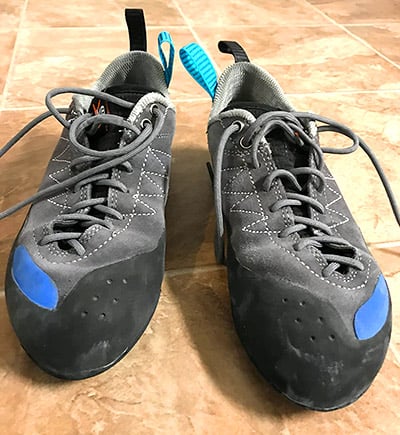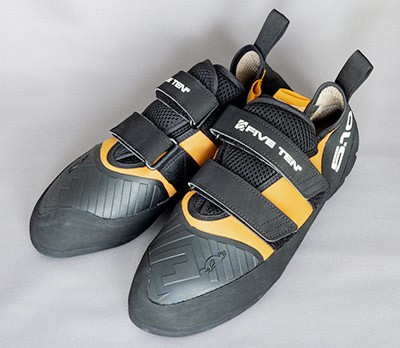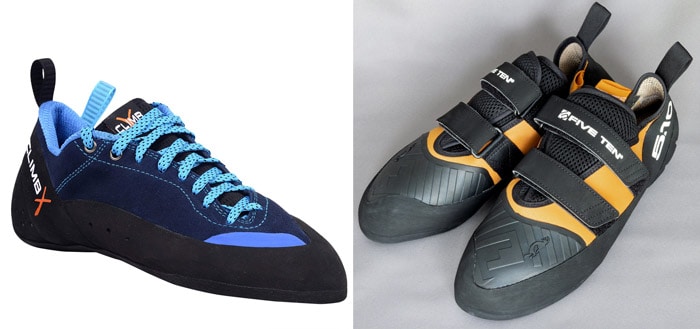For you to do well during the climb, having the right equipment and gear can bring so much difference. One of these essential gear is the climbing shoes, which provide the traction you need when climbing. But even a climbing shoe needs to be selected appropriately as some come in velcro closure while others come in laces.
But what is the difference between lace vs velcro climbing shoes? There are many differences between these two climbing shoes, as this article will break down the differences and compare velcro and laced shoes.
| Features | Velcro Climbing Shoes | Laced Climbing Shoes |
| Climbing Type | Short Sport Routes | Long Trad Routes |
| Downsizing | Recommended | Not Recommended |
| Overall Comfort | Less Comfortable | Comfortable |
| Flexibility and Fitting | Less Flexible | Provides Flexibility |
| Kid Friendly | Yes | Not So Much |
Contents
Type of Climbing
One way to differentiate between lace and velcro climbing shoes is to know what type of climbing they work best. The velcro climbing shoes are perfect for short but sweet sports routes, while the laced climbing shoes are perfect for long and intense trad routes.
If you want maximum performance on shorter routes, velcro climbing shoes should be your choice. The climbing shoes with loop fasteners and nylon hooks fit in this climbing category. The Velcro climbing shoes offer the best performance when doing bouldering, sport climbing, or any other climbing activity requiring extra footwork.
The advantage of Velcro climbing shoes is they are easy to put on and off when compared to those climbing shoes with lace closures. When climbing inside a climbing gym, you can easily remove the shoes if you want to give your feet a break.
On the other hand, if you are climbing the whole day or doing crack or trad climbing, you should use laced climbing shoes. The most significant advantage of this type of climbing shoe is its ability to protect and support your feet when climbing for a long time.
These climbing shoes provide comfort to the feet when climbing all day. Climbing in cracks needs laced climbing shoes to protect your feet better. You will only find a few crack climbers that do not use laced climbing shoes.
Best for Downsizing

Fitting climbing shoes is different when you fit your regular street shoe. During the climb, the climber needs to put a lot of pressure on the toes. If your toes are not located at the front end of your climbing shoe, you will have no control over them during the climb. If you do not have control, the heel tends to move around and can cause you to slip off holds.
For this reason, some climbers need to downsize two to three sizes compared to the regular size of their street shoes. When dealing with highly technical routes, a climber needs a tighter fit to make the feet sensitive and feel the rock during the climb. This situation is where the Velcro climbing shoes work best.
Since a climbing shoe with a Velcro closure system uses straps, pulling them on or off is easy. So, when you are doing extremely high-intensity climbing where you need to give your feet breaks, having this type of climbing shoe works best, significantly if you are downsizing.
When your feet wear smaller shoes, it will put so much pressure on your feet. It can cause unintentional rubbing or pinch to various locations in the foot. When this situation happens, your feet need a break from time to time during the climb. With the Velcro closure, removing or wearing your shoes is easy compared to the laced oneness.
Comfort and Maintenance

If you want to be more comfortable when you climb, laced climbing shoes are your best option. Most laced climbing shoes are made to offer comfort to the user. That is the number one purpose of having laced climbing shoes. These climbing shoes also have better design and construction quality.
In terms of maintenance, the lace of a climbing shoe is so easy to replace when it is old, worn out, or damaged. Meanwhile, this situation will not happen if you have a Velcro closure as this type of system is not replaceable.
Furthermore, Velcro climbing shoes also have some disadvantages when the strap system ages. It will not function like when it was new. It loses its effectiveness when it is worn out or becomes dirty or dusty. So, you need to maintain them carefully to prolong their lifespan.
Flexibility and Fitting
With the comfort that laced climbing shoes bring, it is also worth noting that this climbing shoe also provides flexibility and the right fit. Laced climbing shoes allow you to have a customizable fit compared to their Velcro counterpart. Laced climbing shoes will let you play a little bit when tying them, enabling you to find a more comfortable fitting.
Kid-Friendly
When it comes to being kid-friendly, Velcro climbing shoes are preferred. The softness and precision of the laced climbing shoes make them not ideal for kids. Tying the laces will also not be a fun thing that a kid can do all the time. With the Velcro strap system, it is easy for the kid to take the shoes on and off during the climb.
All About Preference
Personally, choosing between Velcro and lace climbing shoes is about preference. Some brands provide a great feeling with Velcro closures but are not good with laces. Some shoe brands come with nice lace closures but feel awful in Velcro.
The strapping system also depends on the brands and how they construct the closure system of the shoes. It also depends on the feet of the climber. My awkward feet do not fit very well with laces as I like the easy usage of Velcro climbing shoes.
Conclusion
When comparing lace vs Velcro climbing shoes, it is worth noting that both of these shoes come with upsides and downsides. As mentioned earlier, it is all up to you to choose the shoe that will make you comfortable and allow you to maximize your full climbing potential.

